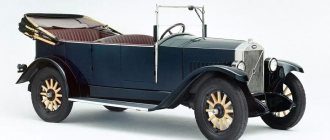Creation
By the 1930s, “car fever” had gripped the country. New giant automobile enterprises were built. Trucks and cars have become increasingly common on public roads, displacing horse-drawn vehicles. Mechanized vehicles began to enter the army. To service the equipment, tools and special equipment were required.
To meet the growing demand, the government decided to organize the work of an enterprise where they would produce body fittings and driver's tools. The town of Pavlovo was chosen as the site. It was successfully located between Moscow and Nizhny Novgorod - the leading automotive centers of the country. The Pavlovsk Bus Plant (PAZ) started operating on December 5, 1932, producing products worth almost 2 million rubles in the first year.
New opportunities
After the war, having close cooperative ties with the Gorky Automobile Plant, PAZ gradually switched to assembling buses. The first five GZA-651 left the factory gates on August 5, 1952. It was a single-door bonnet model based on the GAZ-51, where instead of a body a passenger compartment with 19 seats was mounted.
It took the team of the Pavlovsk Bus Plant 6 years to develop their own cabover model PAZ-652. It was a classic “groove”, which became the most recognizable bus in the USSR (before the advent of the Ikarus era). The design features two automatic pneumatic doors, comfortable seats and increased capacity. If the GZA-651 could accommodate 23 people, then the new model has almost twice as many – 42 (23 of which are seats).
Over 10 years of production (1958-1968), 62,121 units were assembled. The vehicle had high cross-country ability and was mainly intended for various organizations, for transporting passengers along suburban and intercity routes. However, it was also used as public city transport.
The laborious origins of the Paz plant and its equipment
The working chronicle of our legendary bus started back in 1930 - that’s when the Nizhny Novgorod Machine Plant began to build.
To provide it with everything necessary, in 1932 an additional enterprise was built in Pavlovo-on-Oka for the production of a machine device (ZATI). During the Famous Patriotic War, ZATI, like the whole country, switched to producing military equipment. The Pavlovsk Aviation Plant of Automotive Instruments (ZATI) was founded on the 5th asteroid in 1930. Over the course of two flights, the construction of administrative buildings and workshops was completed, and the factory workers began producing equipment and body structures. With the beginning of the Famous Patriotic War, the factory workers guaranteed army equipment with the device. Ammunition output has been improved at the plant in Nizhny Novgorod Square. After the end of the war, until 1952, the initiative resumed producing specific devices for cars.
Record-breaking plant
The Pavlovsk Bus Plant became one of the most important manufacturers of public transport in the USSR. On November 12, 1968, factory workers were the first in the Soviet Union to use the method of switching to a new model without stopping the main conveyor, which helped reduce production costs and reduce changeover time.
PAZ-672 was a development of the previous model. It was produced by the Pavlovsk Bus Plant until 1989. In total, more than 280,000 copies were on the road. In 1982, production of a modernized version of the PAZ-672M began. The model had a longer engine life, interior comfort was improved, the reliability of the power steering was increased, and the optics were redesigned. In total, there were more than 20 modifications and designs, including all-wheel drive.
In market conditions
Even before the collapse of the USSR (in 1989), the Pavlovsk Bus Plant put on the assembly line a new model PAZ-3205, which is still in production today. She was destined to become the most popular in the 90s. The appearance and technical characteristics of the small class bus have not changed much. In general, the design has become more modern, the reliability of the motor and main components has been increased. In 2014, the model was restyled. At the moment, about 145,000 units of PAZ-3205 have been produced. The designers have created about 30 modifications for all occasions:
- single-door;
- two-door;
- passenger;
- cargo-passenger;
- for persons with disabilities;
- VIP and luxury options;
- in the northern version;
- school;
- isothermal;
- all-wheel drive and others.
Our days
Since 2000, PAZ has accelerated the development of modern buses, producing models of various classes. Among them: PAZ-4228, PAZ-4223, PAZ-4234, PAZ-4230 “Aurora”, PAZ-5271, PAZ-5272, PAZ-5220. An important milestone was the creation of the first Russian low-floor city bus PAZ-3237.
Today the company is developing by leaps and bounds. The financial statements for Pavlovsky Bus Plant LLC indicate good financial performance. For example, in 2015, profit increased by 5%, amounting to 318 million rubles. In 2009, PAZ-3204 won the title “Best Russian Small Class Bus.” This became possible thanks to the large-scale modernization of production carried out since 2006.
According to the Swot analysis of the Pavlovsk Bus Plant, the enterprise remains key to the economy of the city of Pavlovo. In fact, it is a city-forming area and makes an invaluable contribution to the development of the area. PAZ, despite the difficult economic situation in the 90s and early 2000s, was able to maintain full production capacity. Every working day, up to 42 units of equipment roll off the assembly line.
The Pavlovsk Automobile Plant assembles about 80% of city buses in Russia and is one of the largest automobile enterprises in the country with rich production experience. In terms of production volume, it is among the top 10 leading global manufacturers.
PAZ - brand history
Pavlovsky Bus (PAZ) is a Soviet and Russian manufacturer of small and medium class buses in Russia. Located in the city of Pavlovo, Nizhny Novgorod region. Part of the GAZ group, which owns 93.79% of the shares.
Since 2005, bus production has been carried out by PAZ LLC, a 100% subsidiary of Pavlovsky Bus PJSC. This allows us to minimize mandatory disclosure of information and reporting according to Russian standards.
The decision to create a plant in Pavlov to supply the Gorky Automobile Plant and other automobile enterprises with driving tools and body fittings was made in 1930. In 1932, construction was completed and production began. The plant at that time was called ZATI (automotive tool plant).
On April 24, 1952, by decree of the USSR Government, the Automotive Tools Plant in the city of Pavlovo-on-Oka was repurposed and renamed the Pavlovsk Bus Plant (PAZ). A plan for the reconstruction of the plant and a program for the production of 10,000 buses were also approved. The first batch begins production, which consists of five hooded buses of the PAZ-651 model. Already on August 5, 1952, the first five buses of the first production model of the hood layout PAZ-651 (GAZ/GZA-651) on the chassis of the mass-produced GAZ-51 truck left the factory gates.
PAZ-651 (GAZ/GZA-651)
In 1958, production began of the first new basic model PAZ-652, developed at the plant, with a carriage (cabless) layout with two multi-leaf doors.
On November 12, 1968, for the first time in the history of the domestic bus industry, without stopping the main conveyor of the PAZ plant, PAZ began producing a new basic model of the enterprise, developed on the basis of the PAZ-652, the PAZ-672, which was produced until 1989. Among its modifications was the all-wheel drive one-door all-terrain model PAZ-3201.
PAZ-672
In the 1960s, the main production concept of the enterprise was fully formalized - satisfying the widest segments of consumers by creating as many modifications of the basic model as possible. It was during these years that the plant participated in international exhibitions for the first time.
On December 1, 1989, serial production of the most popular base model of the plant in the 1990-2000s, the PAZ-3205 bus, began. To date, more than 30 modifications of this bus have been developed for various purposes (specialized and luxury), intended for operation in various climatic conditions. About ten of them are mass-produced.
PAZ-3205
In the late 1990s - early 2000s, new models of medium and large class buses were developed: PAZ-4230 "Aurora", PAZ-4234, PAZ-4223, PAZ-4228, PAZ-5220, PAZ-5271, PAZ- 5272, as well as the first low-floor small-class bus in Russia PAZ-3237.
In 2000, new facilities were put into operation for the production of city and intercity buses of large and medium classes - the three-door PAZ-5272 and the two-door PAZ-4230 Aurora. Due to competition with the main Russian manufacturers of full-size buses - LiAZ and NefAZ - the production of large buses PAZ-5272 and other large series was not established. Also, the medium PAZ-4230 did not become the main model of the plant due to greater market demand for small buses. Its modification KAvZ-4238, according to the technical documentation of PAZ, has been put into production in small batches, and also under license in Kurgan at KAvZ.
In 2000, PAZ became part of the GAZ Group engineering holding, which unites the main manufacturers of buses, trucks and other automotive equipment in Russia.
2003 was a record year for the PAZ plant, largely thanks to a well-structured sales program. PAZ buses are very popular in all regions of our country. Export purchases of buses produced by PAZ are also increasing. The share in total sales in the country is growing every year. The PAZ enterprise won a competition to supply more than 300 buses to Uzbekistan, about 200 buses went to Vietnam.
In 2004, it was planned to rebuild the main conveyor of the PAZ plant using the “just in time” system. As a result, a unified conveyor appeared, which surpassed the old one in many technical parameters. A completely new conveyor has led PAZ to new approaches and principles for organizing the bus manufacturing process, which involve reducing the volume of work in progress.
At the beginning of 2004, construction of the first part of the high-pressure gas pipeline was completed. This made it possible to use the direct gas combustion process at the PAZ plant for the development of new technologies and heating, which significantly reduced costs. Several other new self-financed projects were also proposed.
Since 2006, PAZ has been participating in the national project “Education” by producing special school modifications of PAZ-3205 and PAZ-3206 buses with a unified yellow color.
At the end of the 2000s, the plant created the first Russian low-floor small-class bus PAZ-3237 “Luzhok”, and also to replace the PAZ-3205 family, a new family of small buses with spring suspension was developed - PAZ-3204.
PAZ-3204 was launched into mass production in January 2009, was recognized as “Best Bus of the Year in the Small Class” in 2009-2010, but for a number of reasons has not yet become the base model of the plant. Also in 2009, a modification of the PAZ-3204 with gas cylinder equipment was developed.
At the turn of the 2000-2010s, the plant also developed promising models of PAZ-3202 Valdai and PAZ City buses.
During the restructuring of production facilities, the welding and painting, pressing and metal procurement shops were combined into a single building. The largest production optimization project is related to the assembly shop - the conveyor lines were reduced to four. In 2009, a new generation painting complex “Aizenman” was put into operation.










